mirror CADILLAC FLEETWOOD 1993 2.G Owners Manual
[x] Cancel search | Manufacturer: CADILLAC, Model Year: 1993, Model line: FLEETWOOD, Model: CADILLAC FLEETWOOD 1993 2.GPages: 386, PDF Size: 19.17 MB
Page 128 of 386
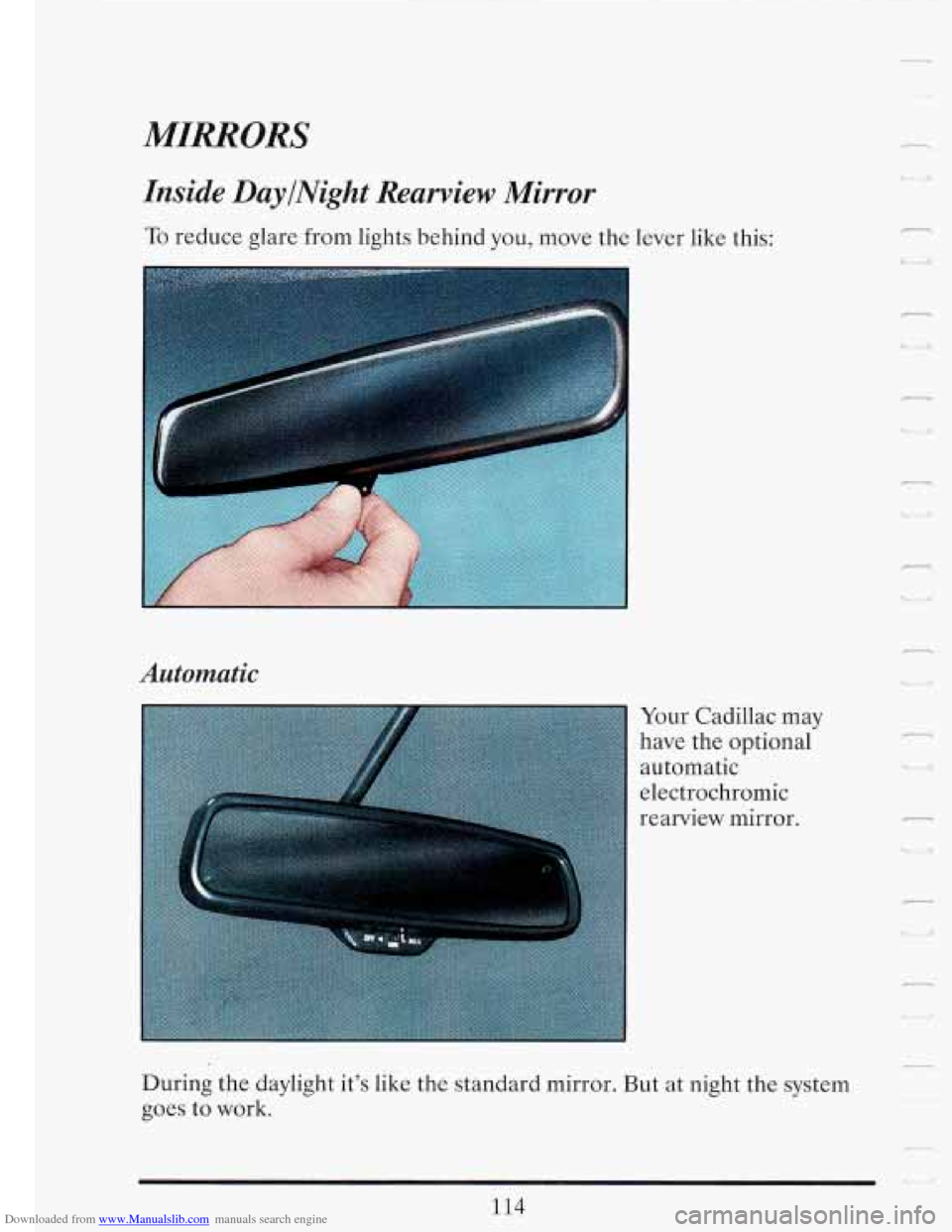
Downloaded from www.Manualslib.com manuals search engine MIRRORS
Inside DaylNight Rearview Mirror
To reduce glare from lights behind you, move the lever like this:
Automatic
Your Cadillac may
have the optional
automatic
electrochromic
rearview mirror.
During the daylight it’s
like the standard mirror. But at night the system
goes to work.
114
r
1y
r
I L-4
U
n
1; U
Page 129 of 386
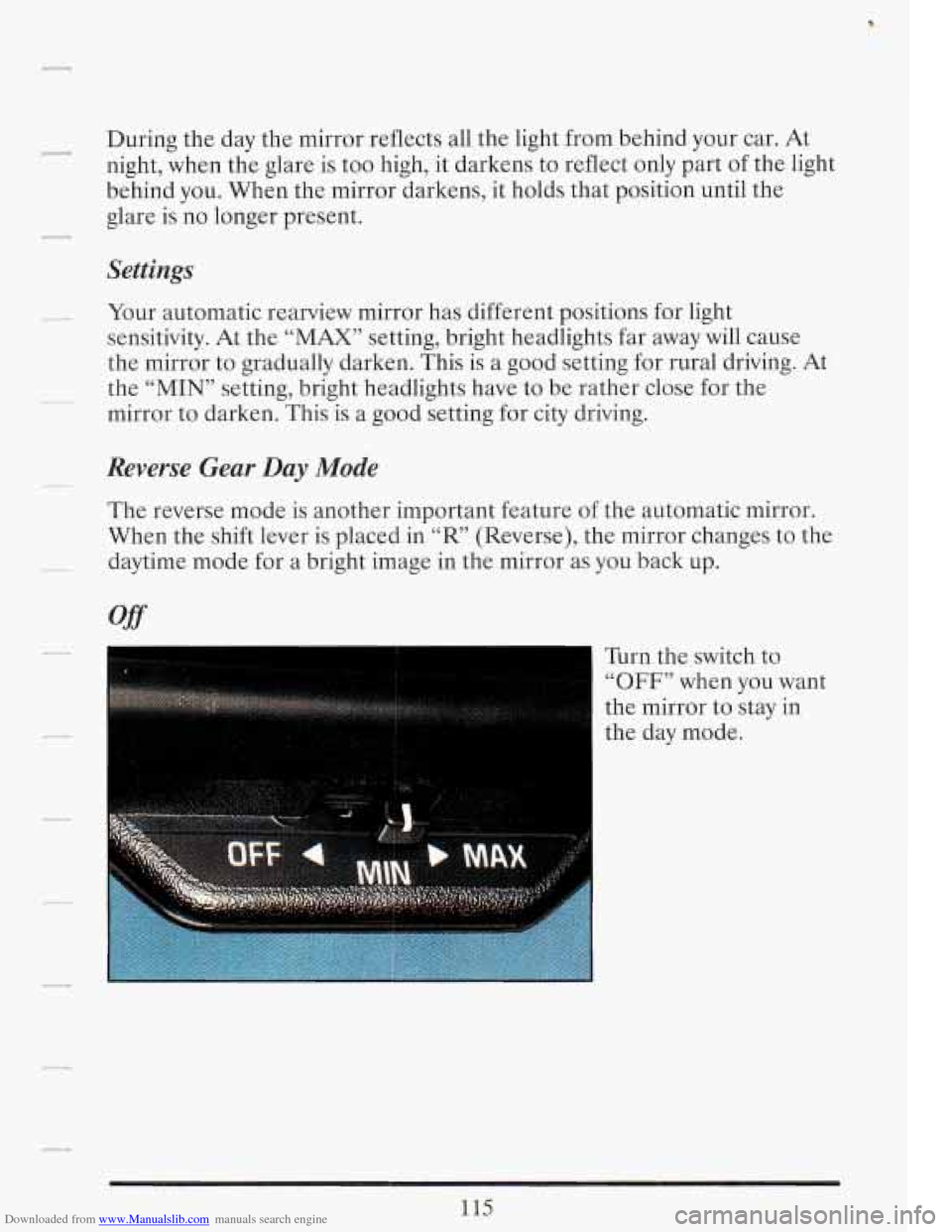
Downloaded from www.Manualslib.com manuals search engine - During the day the mirror reflects all the light from behind your car. At
night, when the glare is too high, it darkens to reflect only part
of the light
behind
you. When the mirror darkens, it holds that position until the
glare is no longer present.
R_
Settings
__ Your automatic rearview mirror has different positions for light
sensitivity. At the
“MAX” setting, bright headlights far away will cause
the mirror to gradually darken. This is a good setting for rural driving. At
mirror to darken. This
is a good setting for city driving.
-- the “MIN” setting, bright headlights have to be rather close for the
Reverse Gear Day Mode
The reverse mode is another important feature of the automatic mirror.
When the shift lever is placed in
“R’ (Reverse), the mirror changes to the
~
__ daytime mode for a bright image in the mirror as you back up.
off
Turn the switch to
“OFF” when you want
the mirror to stay in
the day mode.
115
Page 130 of 386
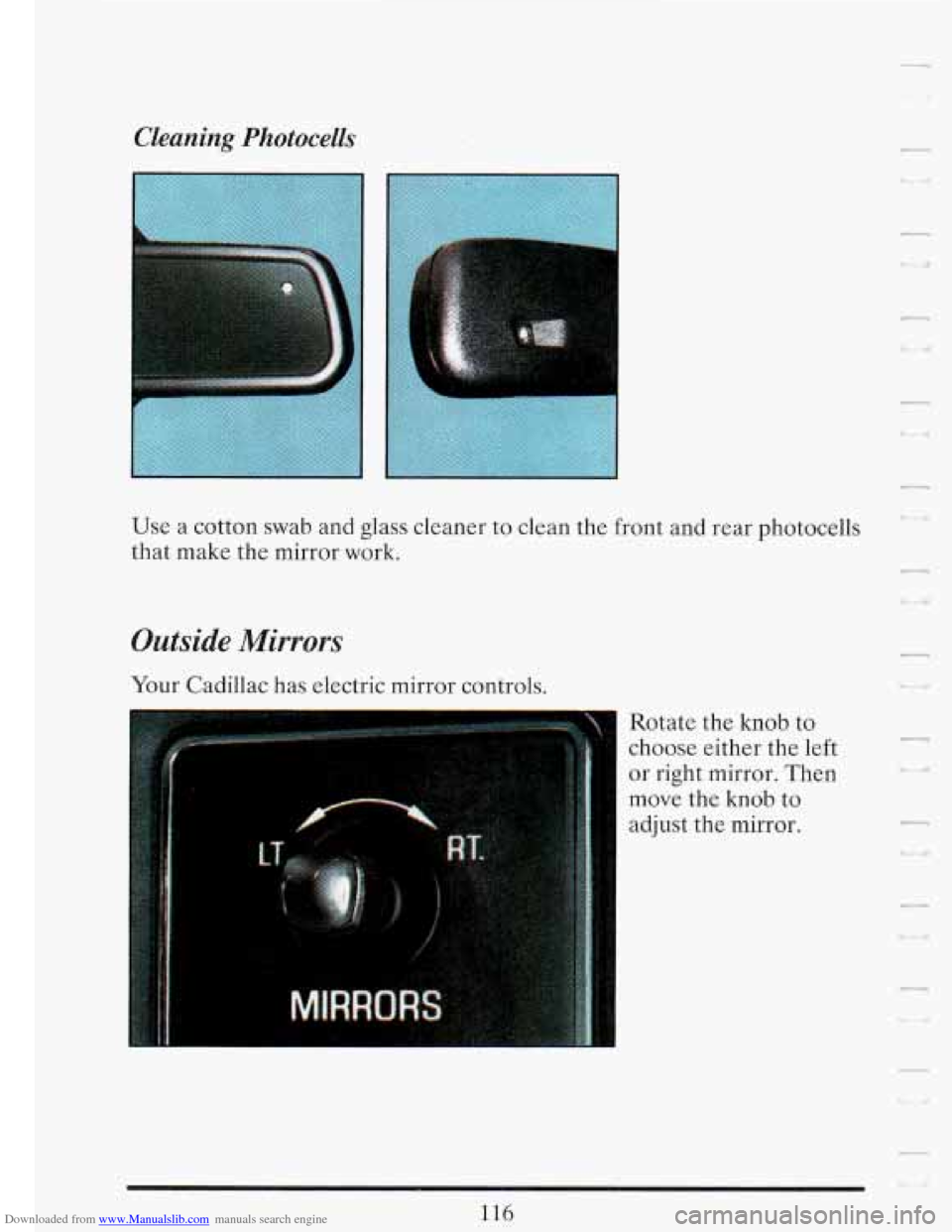
Downloaded from www.Manualslib.com manuals search engine Cleaning Photocells r
c1
Use a cotton swab and glass cleaner to clean the front and rear photocells
that make the mirror work. Li
Outside Mirrors
Your Cadillac has electric mirror controls.
Rotate the knob to
choose either the left
or right mirror. Then
move the knob to
adjust the mirror.
-
U <
Page 131 of 386
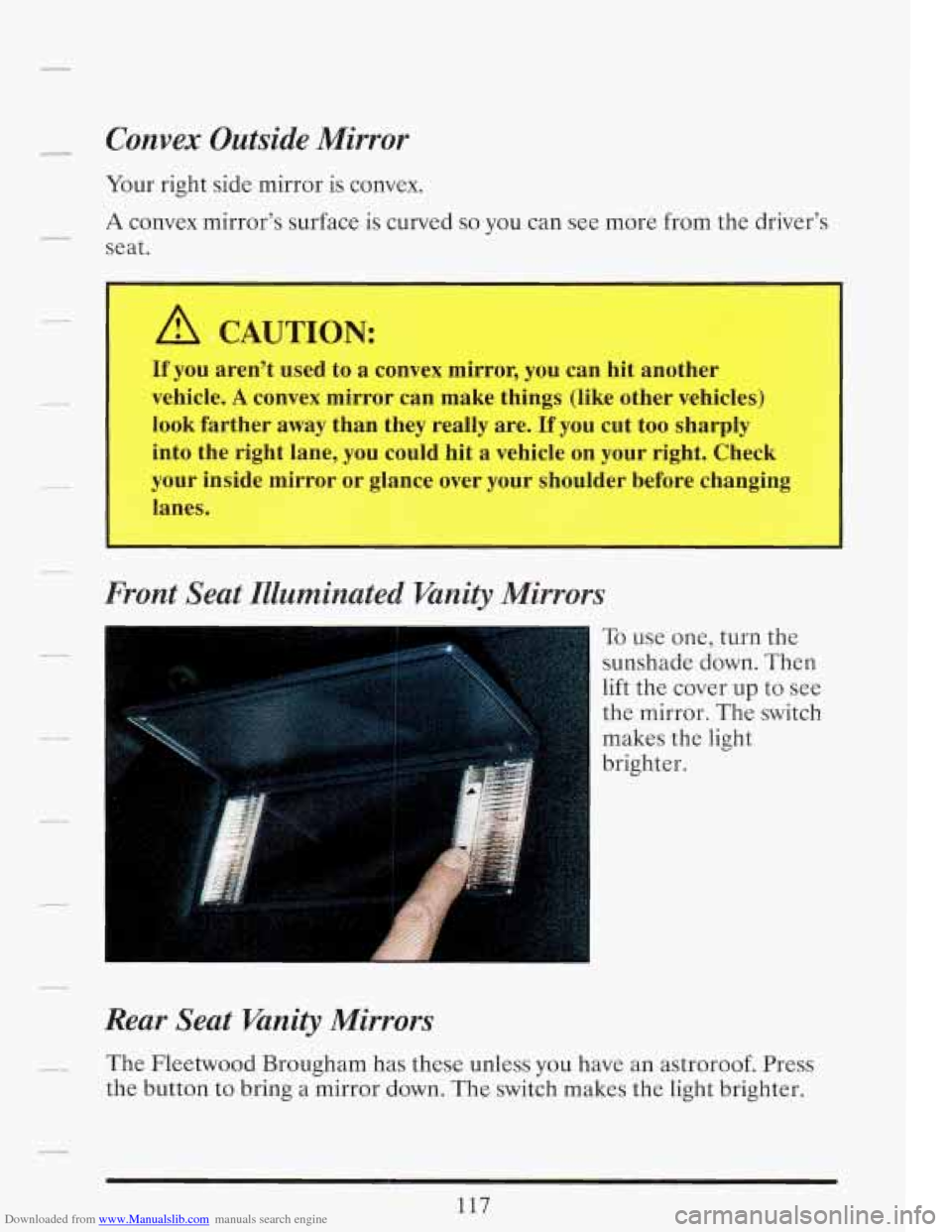
Downloaded from www.Manualslib.com manuals search engine - Convex Outside Mirror
Your right side mirror is convex.
A convex mirror’s surface is curved so you can see more from the driver’s
seat. _1
- 1 A CAUTION:
If you aren’t used to a convex mirror, you can hit another
vehicle.
A convex mirror can make things (like other vehicles)
look farther away than they really are. If you cut too sharply
into the right lane, you could hit
a vehicle on your right. Check
your inside mirror or glance over your shoulder before changing
lanes.
I
To use one, turn the
sunshade down. Then
lift the cover
up to see
the mirror. The switch
makes the light
brighter.
Front Seat Illuminated Vanity Mirrors
Rear Seat Vanity Mirrors
__ The Fleetwood Brougham has these unless you have an astroroof. Press
the button to bring a mirror down. The switch makes the light brighter.
117
Page 156 of 386
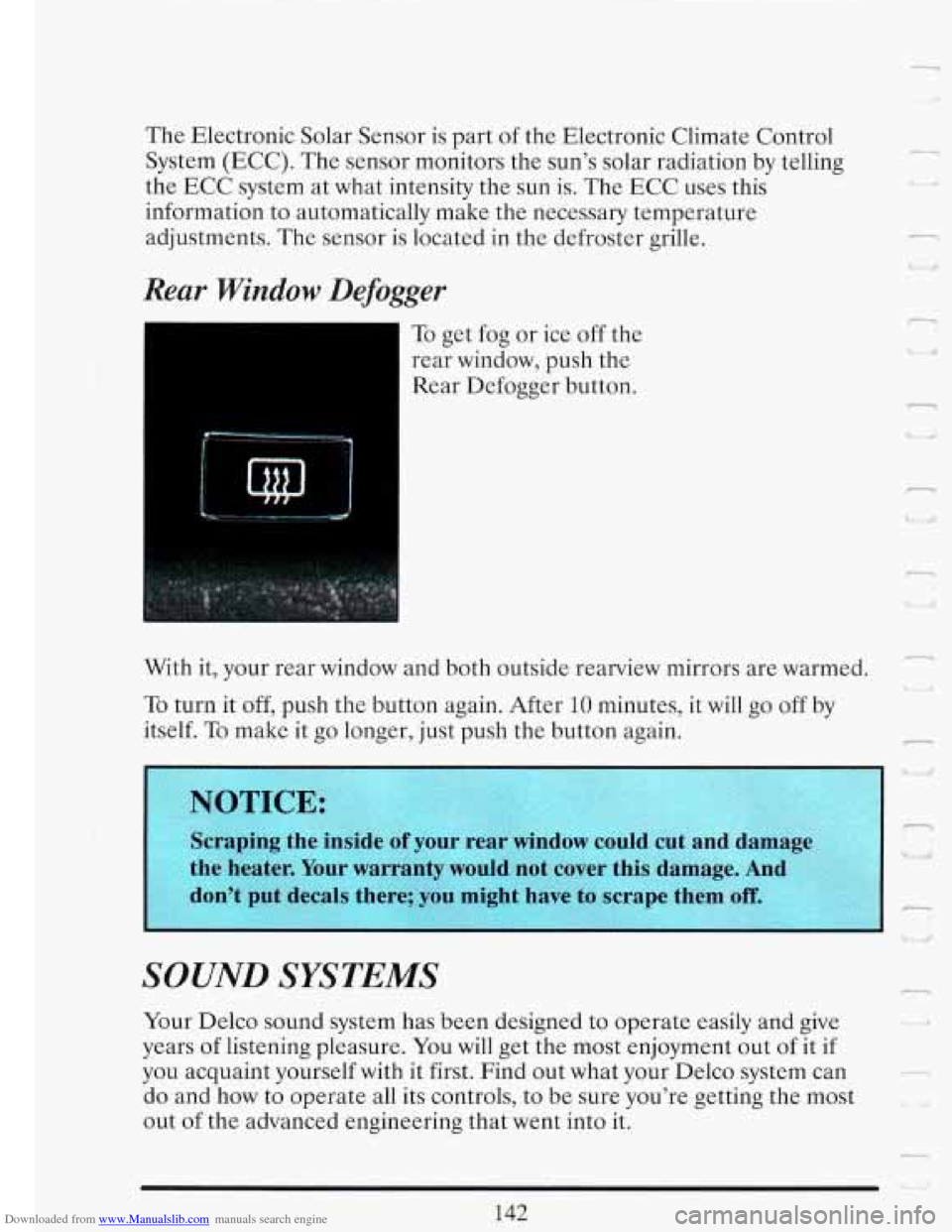
Downloaded from www.Manualslib.com manuals search engine The Electronic Solar Sensor is part of the Electronic Climate Control
System (ECC). The sensor monitors the
sun’s solar radiation by telling
the
ECC system at what intensity the sun is. The ECC uses this
information to automatically make the necessary temperature
adjustments. The sensor is located in the defroster grille.
Rear Window Defogger
To get fog or ice off the
rear window, push the
Rear Defogger button.
With it, your rear window and both outside rearview mirrors are warmed.
To turn it off, push the button again. After
10 minutes, it will go off by
itself. To make it go longer, just push the button again.
n
n .-
-I
SOUND SYSTEMS
Your Delco sound system has been designed to operate easily and give
years of listening pleasure.
You will get the most enjoyment out of it if
you acquaint yourself with it first. Find out what your Delco system can
7.
do and how to operate all its controls, to be sure you’re getting the most - i
out of the advanced engineering that went into it.
1 t d
142
Page 197 of 386
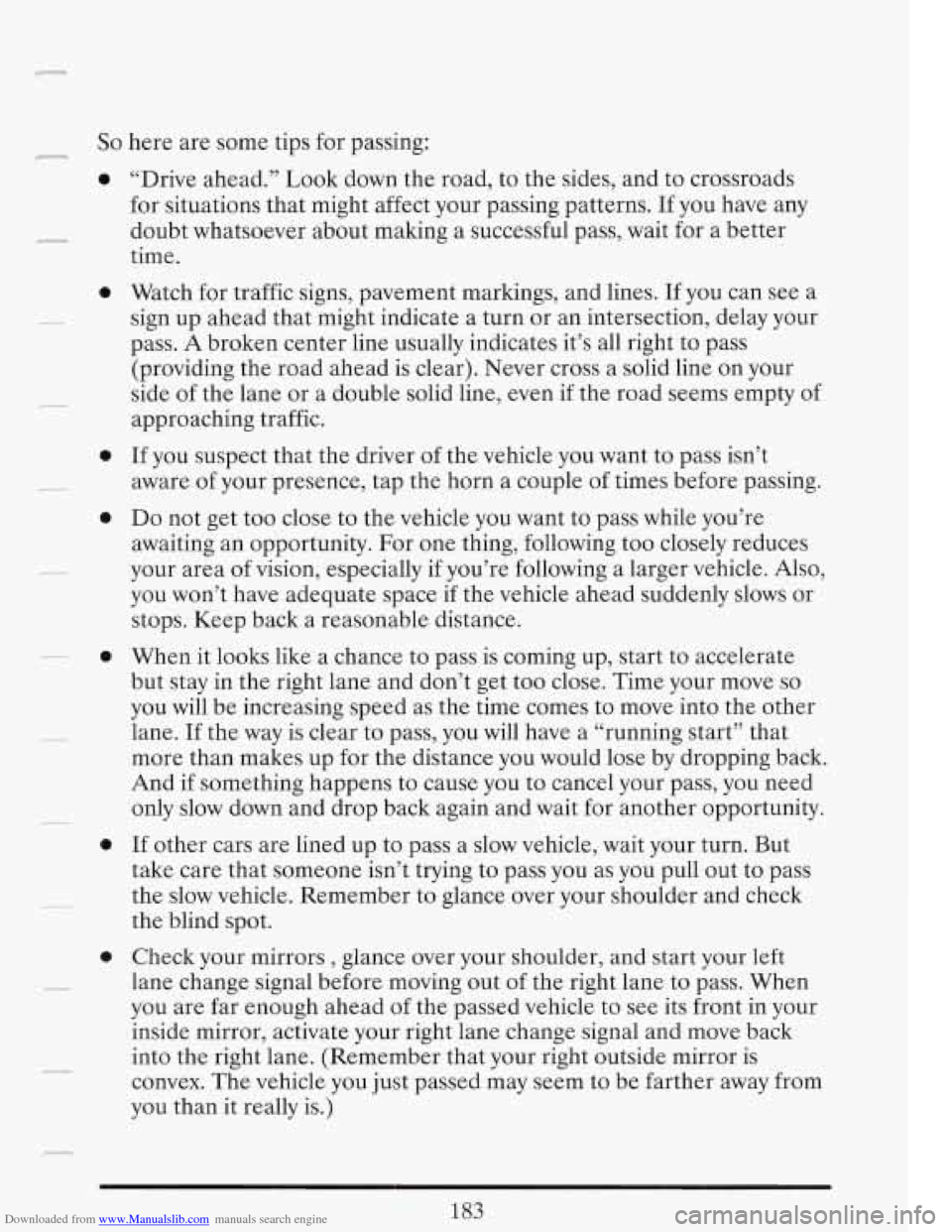
Downloaded from www.Manualslib.com manuals search engine So here are some tips for passing:
0
r
0
0
0
._ 0
0
0
“Drive ahead.” Look down the road, to the sides, and to crossroads
for situations that might affect your passing patterns.
If you have any
doubt whatsoever about making a successful pass, wait for
a better
time.
Watch for traffic signs, pavement markings, and lines. If you can see a
sign up ahead that might indicate a turn or an intersection, delay your
pass.
A broken center line usually indicates it’s all right to pass
(providing the road ahead is clear). Never cross a solid line on your
side
of the lane or a double solid line, even if the road seems empty of
approaching traffic.
If you suspect that the driver of the vehicle you want to pass isn’t
aware
of your presence, tap the horn a couple of times before passing.
Do not get too close to the vehicle you want to pass while you’re
awaiting an opportunity. For one thing, following too closely reduces
your area of vision, especially if you’re following a larger vehicle.
Also,
you won’t have adequate space if the vehicle ahead suddenly slows or
stops. Keep back a reasonable distance.
When it looks like a chance to pass is coming up, start to accelerate
but stay in the right lane and don’t get
too close. Time your move so
you will be increasing speed as the time comes to move into the other
lane. If the way is clear to pass, you will have a “running start” that
more than makes up for the distance you would lose by dropping back.
And if something happens
to cause you to cancel your pass, you need
only slow down and drop back again and wait for another opportunity.
If other cars are lined up to pass a slow vehicle, wait your turn. But
take care that someone isn’t trying to pass you as you pull out to pass
the slow vehicle. Remember to glance over your shoulder and check
the blind spot.
Check your mirrors
, glance over your shoulder, and start your left
lane change signal before moving out of the right lane to pass. When
you are far enough ahead of the passed vehicle to see its front in your
inside mirror, activate your right lane change signal and move back
into the right lane. (Remember that your right outside mirror is
convex. The vehicle you just passed may seem to be farther away from
you than it really is.)
Page 199 of 386
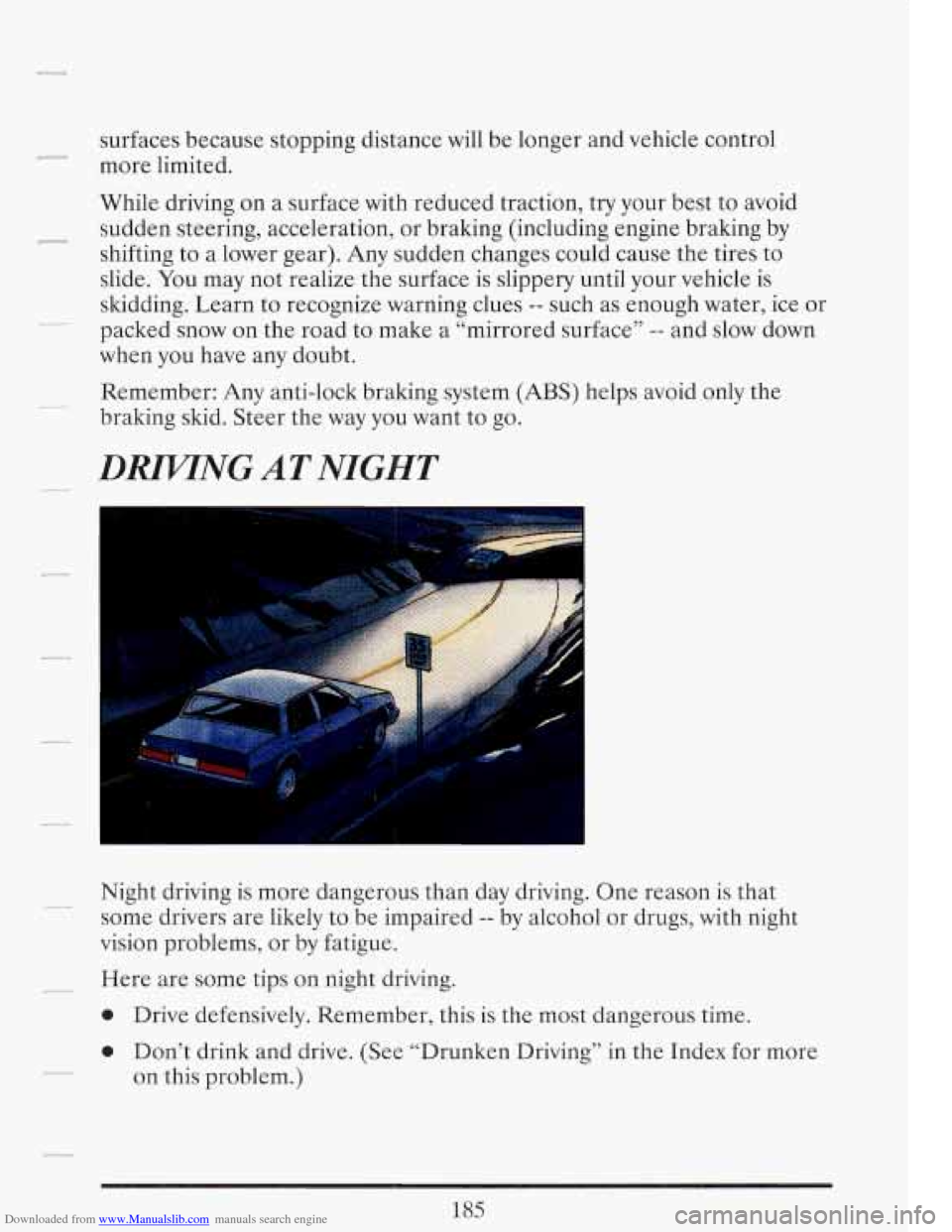
Downloaded from www.Manualslib.com manuals search engine surfaces because stopping distance will be longer and vehicle control
more limited.
While driving on a surface with reduced traction, try your best to avoid
sudden steering, acceleration, or braking (including engine braking by
shifting to a lower gear). Any sudden changes could cause the tires to
slide.
You may not realize the surface is slippery until your vehicle is
skidding. Learn to recognize warning clues
-- such as enough water, ice or
packed snow on the road to make a “mirrored surface”
-- and slow down
when you have any doubt.
Remember: Any anti-lock braking system
(ABS) helps avoid only the
braking skid. Steer the way you want to go.
DRMNG AT NIGHT
Night driving is more dangerous than day driving. One reason is that
some drivers are likely to be impaired
-- by alcohol or drugs, with night
vision problems, or by fatigue. --
I_ Here are some tips on night driving.
0 Drive defensively. Remember, this is the most dangerous time.
0 Don’t drink and drive. (See “Drunken Driving” in the Index for more
on this problem.)
Page 200 of 386
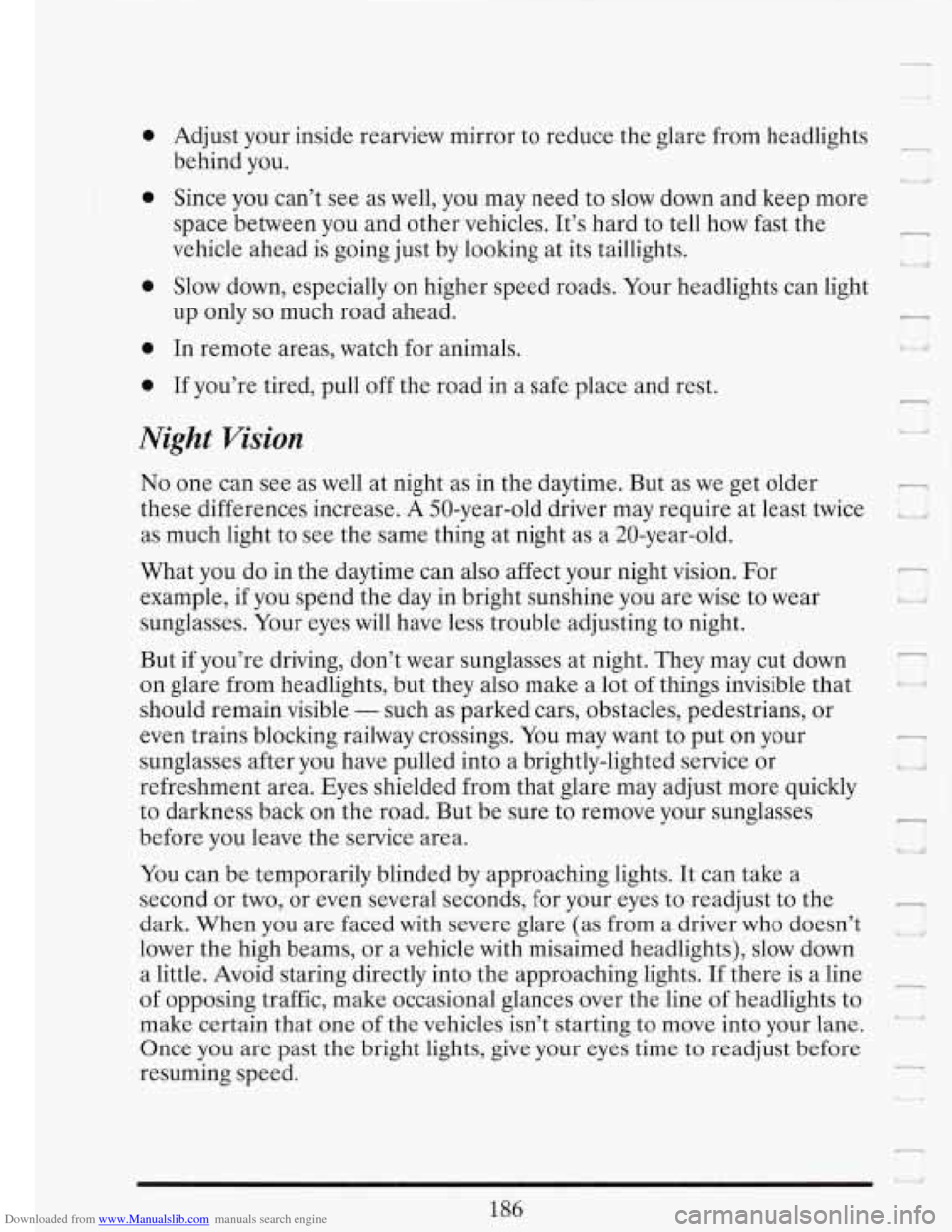
Downloaded from www.Manualslib.com manuals search engine 0
0
0
0
0
Adjust your inside rearview mirror to reduce the glare from headlights
behind you. -
Since you can’t see as well, you may need to slow down and keep more
space between you and other vehicles. It’s hard to tell how fast the
vehicle ahead is going just by looking at its taillights.
Slow down, especially on higher speed roads. Your headlights can light
up only
so much road ahead.
In remote areas, watch for animals.
If you’re tired, pull off the road in a safe place and rest.
Night Vision
f-I
i
No one can see as well at night as in the daytime. But as we get older -
these differences increase. A 50-year-old driver may require at least twice i,
as much light to see the same thing at night as a 20-year-old.
What you do in the daytime can also affect your night vision. For
example, if you spend the day in bright sunshine you are wise to wear
sunglasses. Your eyes will have less trouble adjusting to night.
But if you’re driving, don’t wear sunglasses at night. They may cut down
on glare from headlights, but they also make a lot of things invisible that
should remain visible
- such as parked cars, obstacles, pedestrians, or
even trains blocking railway crossings.
You may want to put on your
sunglasses after you have pulled into a brightly-lighted service or
refreshment area. Eyes shielded from that glare may adjust more quickly
to darkness back on the road. But be sure to remove your sunglasses
before you leave the service area.
I
3:
You can be temporarily blinded by approaching lights. It can take a
second or
two, or even several seconds, for your eyes to readjust to the r
dark. When you are faced with severe glare (as from a driver who doesn’t
lower the high beams, or a vehicle with misaimed headlights), slow down
a little. Avoid staring directly into the approaching lights.
If there is a line
of opposing traffic, make occasional glances over the line of headlights to
make certain that one of the vehicles isn’t starting to move into your lane.
Once you are past the bright lights, give your eyes time to readjust before
resuming speed.
I.-
-
i*
It 81
186
Page 201 of 386
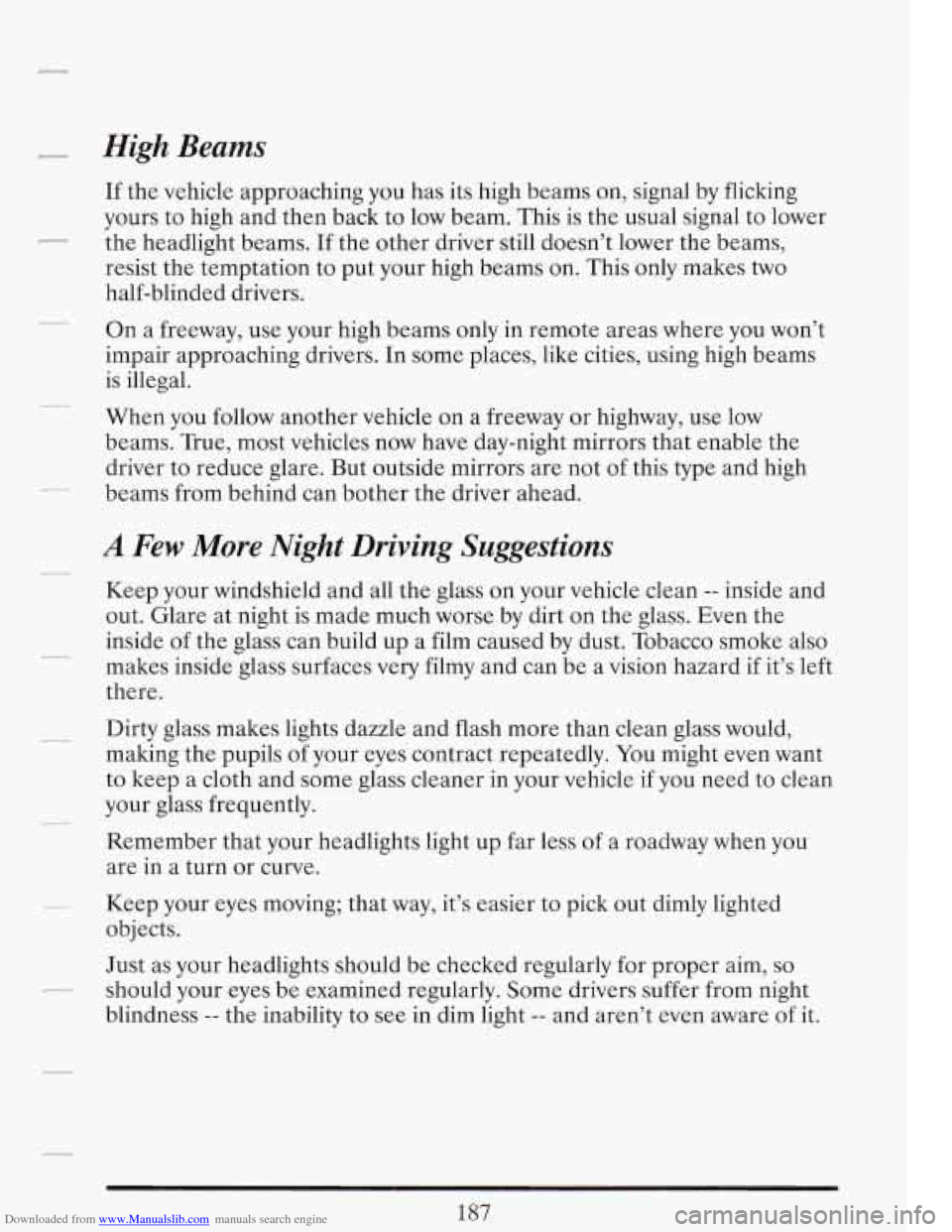
Downloaded from www.Manualslib.com manuals search engine r High Beams
If the vehicle approaching you has its high beams on, signal by flicking
yours to high and then back to low beam. This is the usual signal to lower
the headlight beams.
If the other driver still doesn’t lower the beams,
resist the temptation to put your high beams on. This only
makes two
half-blinded drivers.
- On a freeway, use your high beams only in remote areas where you won’t
impair approaching drivers. In some places, like cities, using high beams
is illegal.
When you follow another vehicle on a freeway or highway, use low
beams. True, most vehicles now have day-night mirrors that enable the
driver to reduce glare. But outside mirrors are not of this type and high
beams from behind can bother the driver ahead.
-
-
A Few More Night Driving Suggestions
-
Keep your windshield and all the glass on your vehicle clean -- inside and
out. Glare at night is made much worse by dirt on the glass. Even the
inside
of the glass can build up a film caused by dust. Tobacco smoke also
makes inside glass surfaces very filmy and can be a vision hazard
if it’s left
there. -
~ Dirty glass makes lights dazzle and flash more than clean glass would,
making the pupils
of your eyes contract repeatedly. You might even want
to keep a cloth and some glass cleaner in your vehicle if you need to clean
your glass frequently.
Remember that your headlights light up far less
of a roadway when you
are in a turn or curve.
-
_- Keep your eyes moving; that way, it’s easier to pick out dimly lighted
objects.
Just as your headlights should be checked regularly for proper aim, so
blindness
-- the inability to see in dim light -- and aren’t even aware of it.
- should your eyes be examined regularly. Some drivers suffer from night
187
Page 209 of 386
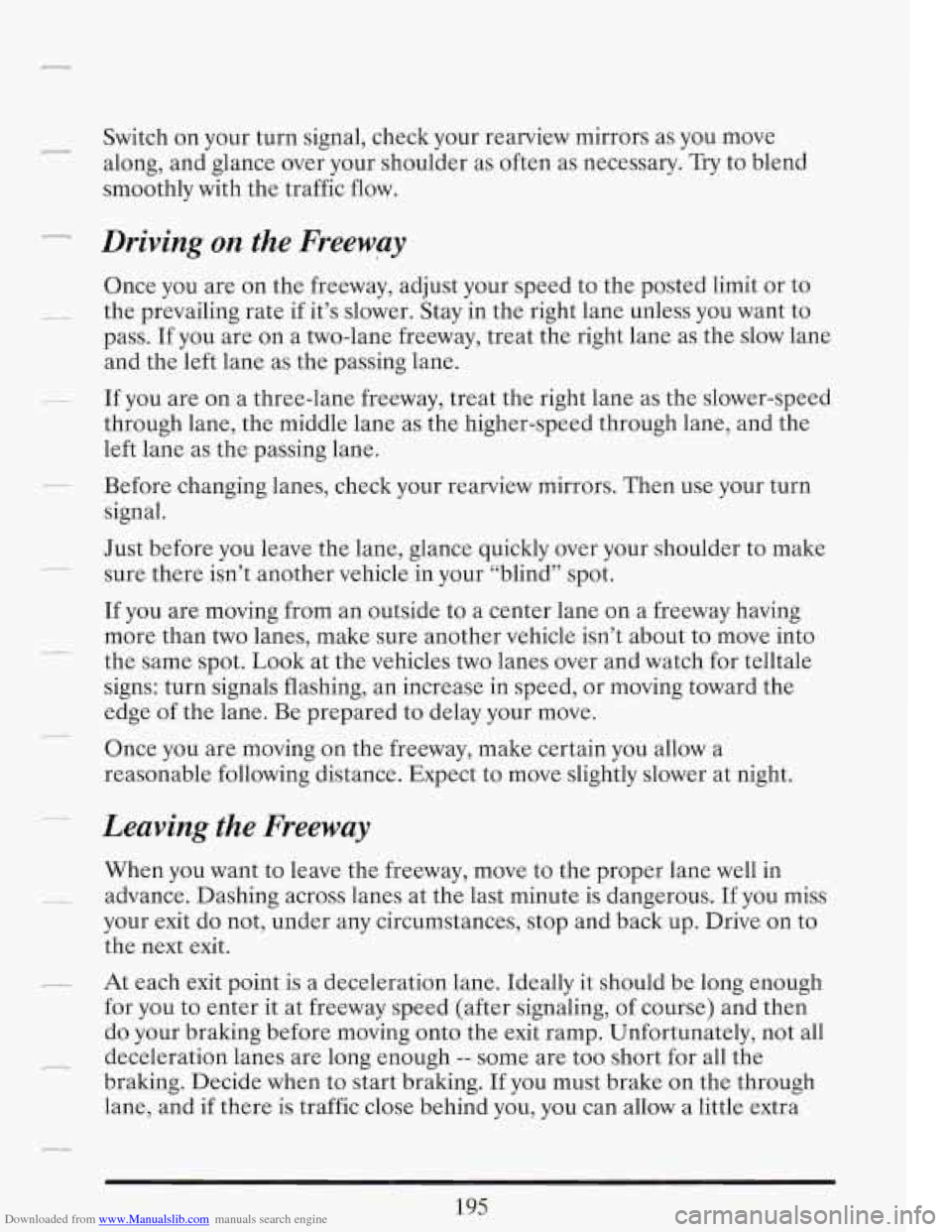
Downloaded from www.Manualslib.com manuals search engine r
Switch on your turn signal, check your rearview mirrors as you move
along, and glance over your shoulder as often as necessary.
Try to blend
smoothly with the traffic flow. c-
_I Driving on the Freeway
Once you are on the freeway, adjust your speed to the posted limit or to
-- the prevailing rate if it’s slower. Stay in the right lane unless you want to
pass.
If you are on a two-lane freeway, treat the right lane as the slow lane
and the left lane as the passing lane.
through lane, the middle lane as the higher-speed through lane, and the
left lane as the passing lane.
- If you are on a three-lane freeway, treat the right lane as the slower-speed
L_ Before changing lanes, check your rearview mirrors. Then use your turn
signal.
Just before you leave the lane, glance quickly over your shoulder to make
sure there isn’t another vehicle in your “blind” spot.
If you are moving from an outside to
a center lane on a freeway having
more than two lanes, make sure another vehicle isn’t about to move into
the same spot. Look at the vehicles
two lanes over and watch for telltale
signs: turn signals flashing, an increase in speed, or moving toward the
edge
of the lane. Be prepared to delay your move.
-
._.
_I
Once you are moving on the freeway, make certain you allow a
reasonable following distance. Expect to move slightly slower at night.
c_
Leaving the Freeway
When you want to leave the freeway, move to the proper lane well in
__ advance. Dashing across lanes at the last minute is dangerous. If you miss
your exit do not, under any circumstances, stop and back up. Drive on to
the next exit.
- At each exit point is a deceleration lane. Ideally it should be long enough
for you to enter it at freeway speed (after signaling, of course) and then
do your braking before moving onto the exit ramp. Unfortunately, not all
braking. Decide when to start braking.
If you must brake on the through
lane, and
if there is traffic close behind you, you can allow a little extra
- deceleration lanes are long enough -- some are too short for all the
195